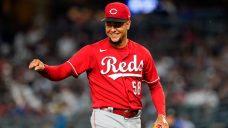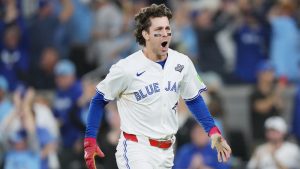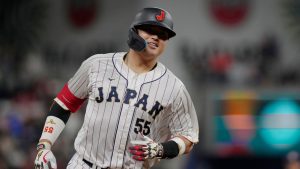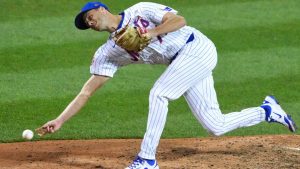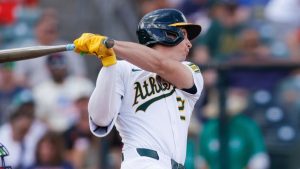TORONTO — The Toronto Blue Jays will be a different looking team later this week as four players acquired in three separate deals prior to Tuesday’s MLB trade deadline report for duty.
There’s a clear throughline connecting the four players — versatile, floor-raising, and controllable. But they’ll each bring their own unique traits to the Blue Jays, so let’s have a look at what the club is adding for the stretch run and beyond.
RHP Anthony Bass
You might remember Bass from the 2020 vintage of the Blue Jays bullpen, leaning on a mid-90’s sinker and striking out 21 per cent of the batters he faced while pitching to a 3.51 ERA over 25.2 innings — many of them high leverage. But the Bass who will return to Toronto this week won’t look much like that guy at all.
Bass still has his firm sinker, but he’s dramatically reduced his usage of it, relying much more heavily on an 86-mph slider he’s thrown nearly 57 per cent of the time this season. That’s what’s behind the 1.41 ERA he’s carried through his first 45 appearances of 2022, the seventh-best mark among MLB relievers.
"He's been great. He really has. We were really impressed with his time here and have been really impressed with his career over its entirety — and certainly over the last year, year-and-a-half,” said Blue Jays GM Ross Atkins. “I think one of the things that's a bit different is his slider usage and the effectiveness of that pitch. But him pitching late in games for us and complimenting Yimi [Garcia] and [Adam] Cimber and Timmy [Mayza] is exciting to think about.”
That usage adjustment — which has occurred progressively since Bass signed a two-year, $5-million free agent contract with the Marlins following his 2020 campaign with Toronto — has juiced Bass’s strikeout rate up to 26 per cent this season, while helping shave over three points off the 9 per cent walk rate he produced in 2020. And it's nudged essentially every peripheral worth caring about — hard-hit rate, barrel rate, whiff rate, chase rate, etc. — in the direction you’d want it to go, as well.
Now, there’s obviously more that goes into it than Bass simply flipping the usages of his fastball and slider. The former plays best to his arm-side, and the latter to his glove-side. The spin direction of the two pitches mirror one another, too, creating deception and separation when he can locate them where he wants to.

Here's what that looks like from an Oneil Cruz plate appearance about a month ago. Bass starts the talented Pirates rookie with a glove-side slider for a called strike, before getting him to chase an arm-side sinker and finishing him off with a slider below the zone:
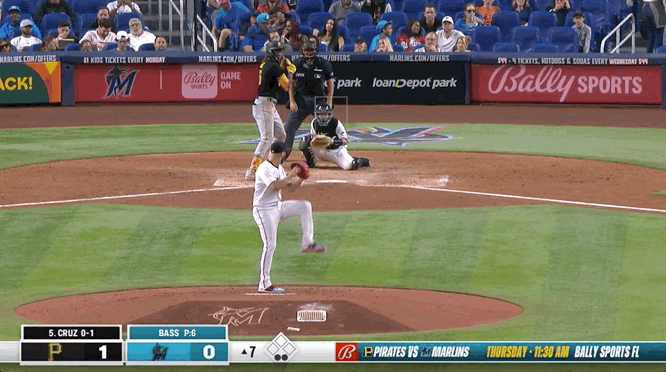
And for a closer look at how deceptive Bass can be when he’s on, here’s the first two pitches of that plate appearance slowed down and overlayed:

That’s what Bass needs to do — live down and to the edges of the strike zone with his slider and sinker, landing both on the corners just often enough to earn called strikes and keep hitters swinging. That’s how he’s generated an 86th percentile chase rate while earning 28.3 per cent of his strikes looking this season.
And while it can be a fool’s errand to try to project a reliever beyond a span of moths, it’s worth noting that the Blue Jays have also inherited a club option in Bass’ contract for $3-million next season. If he stays healthy and continues to produce the results he has, picking up that option would be a no-brainer for the Blue Jays this winter as they seek to build out their bullpen for another contention year in 2023.
RHP Zach Pop
Pop’s huge 63 per cent groundball rate is what sticks out from his brief 2022 big-league sample, as it ranks fourth among the 460 MLBers to throw at least 20 innings this season. He does it by living at the bottom of the zone with a mid-to-high 90’s sinker — Pop’s run it up to 99-mph on occasion — with well above-average vertical movement, eschewing swing-and-miss in favour of weak contact bounced toward shifted infielders:
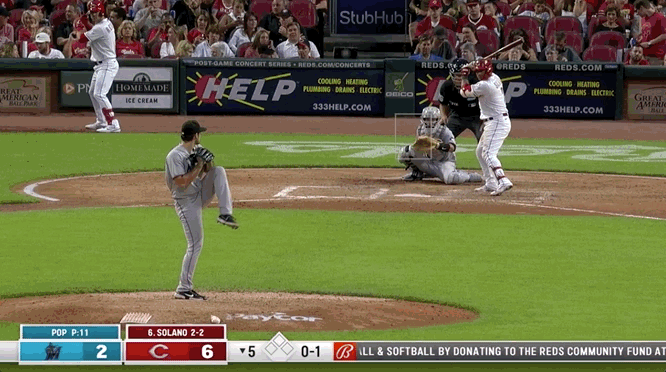
Pop’s averaging only 3.29 pitches per plate appearance, which ranks second among those 460 pitchers. When he’s on and locating his sinker at the bottom of the zone, he’s forcing hitters into an impossible position — either take the pitch and hope it isn’t called a strike or beat it into the ground.
The downside is Pop’s lack of a reliable secondary pitch. He’s used his slider only 16 per cent of the time this season and given up plenty of hard contact with it. He had more success with the pitch last season, when he threw it 32 per cent of the time and generated a promising 31 per cent whiff rate. But it was still hit hard when batters put it in play.
Pop’s slider moves plenty, averaging two more inches of drop than a league-average slider. But he either hasn’t had much trust in it or hasn’t much needed it so far this season. Maybe it’s both. Either way, it’s a pitch the Blue Jays will try to help him improve.
“Zach has a power sinker and a very good slider that we think will complement that pen well,” Atkins said. “Much of it will come from the experience and him getting more exposure to Major League Baseball. He's already been more than effective at this level. But the consistency around that power sink in the zone is enough to be very excited about.
“So, I think [slider improvement] will come with being even more consistent with the location of it, the usage against different styles of hitters, and different types of hitters. There are opportunities with the slider. It's already a very good one. He's very sinker heavy and we don't see lots of things that we see as changes. We see small opportunities that we'll work with him on.”
Another big benefit for the Blue Jays roster-wise is that Pop’s still optionable and gives the club flexibility at the end of its bullpen. The Marlins have already been shuttling him between triple-A and the majors throughout the season, and the Blue Jays will be able to do the same for two more years to come if they so choose. And because of all the time he’s spent in the minors this year, Pop can’t surpass two years of service time for his career by the end of the season, meaning the Blue Jays will hold club control over him through 2027.
Of course, projecting club control for a reliever over five seasons is akin to trying to project how the cryptocurrency market will behave over that time. If Pop plays out the entirety of his club control in the Blue Jays bullpen it will be an unbelievable, 99th percentile outcome. But, at the very least, he provides flexibility for the Blue Jays over his near-term, optionable years.
Utility IF/OF Whit Merrifield
It couldn’t have been fun for Whit Merrifield to look up at the Kauffman Stadium scoreboard a month into the season and see the numbers staring back at him. On May 9, 26 games and 113 plate appearances into his campaign, Merrifield was batting .135/.177/.164 and was about to be dropped to No. 8 in the Kansas City Royals batting order after hitting either leadoff or in the two-hole for them everyday for over half a decade.
That shocking start is part of the reason why Merrifield’s overall offensive numbers this season — he’s now carrying a .240/.290/.352 line with an 80 wRC+ — stand out in comparison to the above league-average production he provided through the first six seasons of his late-starting career (the right-handed hitter made his MLB debut at 27).
But he’s been much better since hitting that nadir in early May, batting .280/.332/.423 over 69 games and 307 plate appearances since, good for a 112 wRC+ that falls more in line with his best seasons in 2018 and ’19. Layer in strikeout (14.5 per cent), walk (7.1 per cent), and contact (82.8 per cent) rates not far off his career averages, and you can see why the Blue Jays felt they could raise their floor at multiple spots by adding Merrifield to an already-deep position player rotation.
And that’s Merryfield’s best trait, after all. Versatility. He’s logged over 500 major-league innings at second base, right field, and centre field, with a decent sample of play in left field, as well. He spent some time at shortstop in the minors, and the Blue Jays wouldn’t be opposed to using him at third base in a pinch. He’s not a power threat at the plate, but he is routinely one of the game’s top contact hitters and has led the majors in steals three times, including last season when he swiped 40 bags.
He just does a little bit of everything, relying on a quick bat and quick feet — Merryfield’s still sporting 83rd percentile sprint speed at the age of 33 — to make athletic plays around the diamond. Consistent playing time may not always be easy to find when all of Toronto’s regulars are healthy and performing. But when is that ever the case?
Say George Springer needs a brief IL stint to let what’s ailing his bothersome right elbow calm down. Say Santiago Espinal’s summer slump continues. Say Teoscar Hernandez or Lourdes Gurriel Jr. need a day off their feet. That’s where Merrifield fits in — everywhere.
“He's such a good player — very accomplished with incredible experiences. The versatility, the contact ability, the speed, playing multiple positions, incredible baserunner — feel very good about him at so many different positions and that versatility will help us down the stretch,” Atkins said. “Between him and Cavan (Biggio), Raimel (Tapia), and others, we feel like we can really protect and keep guys, from time-to-time, off their feet.
“In the event of an injury, we're very well covered. Whit we see as an everyday player and hopefully we'll be able to balance that well. I know John Schneider and his staff will work hard to balance that well for everyone.”
Merrifield’s positioned to be a part of future Blue Jays rosters, as well, after restructuring his contract with the Royals prior to the season. He’s owed a very reasonable $6.75-million salary in 2023, and carries a mutual option of $18-million — with a $500,000 buyout — for 2024. Exactly how he’ll fit Toronto’s roster in the near-term remains to be seen. But considering how reliable injury and underperformance is over a 162-game season, there’s little doubt a need will present itself before long.
RHP Mitch White
With Ross Stripling near indispensable to the Blue Jays rotation, and Max Castillo out the door in the Merrifield deal, Mitch White immediately steps in to an underappreciated swingman role with his new club.
Over 56 innings spread between 10 starts and five relief appearances for the Los Angeles Dodgers this season, the 27-year-old carries a 3.70 ERA over 56 innings — a number pulled up substantially by a particularly rough day against the St. Louis Cardinals in which he coughed up six runs over five. Strike that outing from White’s record and his ERA drops to an even 3.00.
Of course, baseball doesn’t work like that. And White’s peripherals (19.8 per cent strikeout rate; 8 per cent walk rate; 20.1 per cent whiff rate) aren’t blowing anyone away. But league-average arms capable of oscillating between starting and relieving aren’t common, which is what has made Stripling so valuable to the Blue Jays this season. And with Stripling a free agent this winter, and the swingman spot he vacated to join the rotation never properly backfilled, White provides the Blue Jays a couple layers of insurance.
"He's certainly done that and I think that's a fair assessment to think of someone filling that role,” Atkins said of comparing White to Stripling. “You see it more and more in the game today. It really comes down to the ability to start that is so attractive — someone that can go five or six innings, throw 100 pitches, has the ability to get right-handers and left-handers out. The arsenal to do that and the athleticism to hold up and the durability are all things that aren't easy to acquire.”
White isn’t arbitration eligible until 2025, and is under team control through 2027, giving the Blue Jays plenty of flexibility should Stripling depart in free agency this off-season. And with a deep repertoire including a pair of 94-mph fastballs, a slider with above-average movement that plays well against right-handed hitting, and a big curveball he’ll use against lefties, there’s plenty here for the Blue Jays pitching department to work with.

